
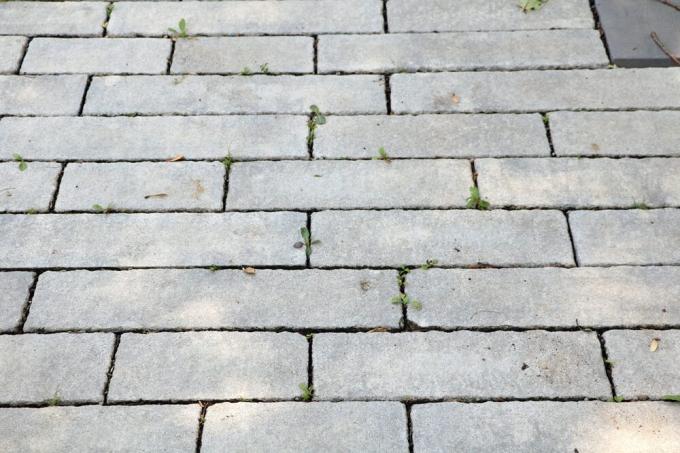
Table of contents
- home remedies
- weeding
- cooking water
- high pressure cleaner
- combustion
- Weed Killer Law
- Chemical weed killer
- Prevent
- bud pruning
- root weed
- gravel
- weed fleece
- joint closure
- vinegar cleaning
- sealing
- Conclusion
Weeds do not stop at the joints between the paving stones. Especially here countless species find optimal conditions. Once a weed has grown, it usually does not take long before it multiplies, more weeds grow and spread rapidly over many meters in the paving stone joints. Weed control is not one of the most popular activities, especially between paving stones. Here you can find out which methods are really effective faster or less quickly, what you should not do and how you can intelligently prevent it.
home remedies
If you don't want to rely on chemical products, you can tackle the weeds in the joints of paving stones with simple household remedies. But be careful, because weed killers are also hidden here, the use of which is only permitted to a limited extent and can result in extremely expensive penalties if disregarded.
weeding
The gentlest, but probably also the most strenuous weed killer is pulling by hand. Pulling weeds here and there in passing is certainly the most convenient method, but not the most effective, since weeds that remain will continue to multiply. Here you will only have long-term success if you meticulously pull out all weeds in the stone joints within a short time frame.
You can simplify weeding with a joint scraper, which was specially developed for weed control in narrow crevices. They are easy on your fingers. So-called telescopic weeders, into which a joint scraper can also be inserted, are ideal. With this device, you no longer need to bend down, protect your back and can reliably and completely remove roots that are firmly anchored in the ground with a narrow weeder.
Tip:
It is easier to completely remove roots from the paver joints if the soil in the cracks is well soaked. The water should be given about an hour to get deep into the soil before you start weeding.
cooking water
With the help of boiling hot water, you can effectively destroy weeds in the stone joints if they are shallow-rooted and slender species, such as:
- Common yarrow (Achillea millefolium)
- Young bear pod (Astragalus glycyphyllos)
- Canadian Fleabane (Conyza canadensis)
For dandelions, thistles or similar, this method of weeding is only suitable for small young plants whose shoots are still thin and roots are not yet strengthened.
Boiling water destroys the fine plant structure and allows it to shrink. Depending on the type of weed, this process usually takes between two and four days. You may have to pour hot water several times, which ultimately also speeds up the dying process. Since the joints between the paving stones are usually really narrow, a little skill is required to let the water run in sufficiently so that the roots can also be reached.
high pressure cleaner
You can only achieve a promising result with a high-pressure cleaner if you use it with at least 100 bar and hold it directly in the joints. Most weed species are flat-rooted and can usually be easily pushed out by the high water pressure. However, you can also lift soil or gravel out of the joints with the high-pressure cleaner, which is not advantageous, especially with wider joints. Therefore, this method is only recommended for joints up to a maximum of three millimeters.
combustion
Burning is a very common way to kill weeds. This is less achievable with a conventional camping gas burner. There are special gas burners with an integrated gas cartridge for this, which are available from specialist retailers or hardware stores. Here you hold the flame on the weed for a few seconds until it burns down. Then aim well into the joints so that you can reach the root with the flame. The root core is always in the upper area. If this is burned, the root can no longer grow and the rest can remain in the ground. Subsequent removal is therefore not necessary.
Tip:
Always wear safety goggles when using a burner as a weed killer because small sparks can form and hot plant debris can fly around. If they get into your eyes, it can cause serious damage.
Weed Killer Law
Albeit vinegar and salt in appropriate concentrations for their extreme effectiveness against weeds are known, their use to kill weeds on "unsealed areas" is made by law FORBIDDEN. “Unsealed areas” are to be understood, among other things, as cobblestone areas that do not have any have a sealing protective layer and thus prevent moisture from penetrating into the soil allows.

This is regulated by the Plant Protection Act, which states that vinegar and salt have a high weed killer effect Require concentration and thereby an environmental hazard due to the inability to biodegrade comes.
In short this means:
You may not use these "home remedies" on your paved patio, driveway or other places with access to the ground, otherwise you could face a fine of up to 50,000 euros.
Chemical weed killer
There is a wide range of chemical weed killers on offer. The handle is quickly turned into an unsuitable product.
Just like weed control with vinegar and/or salt, there are also chemical weed killers that work on the wrong ones places of use have criminal consequences due to a breach of the environmental and/or plant protection law could. For example, there are numerous weed killers for lawns that are absolutely unsuitable for weeds in the joints of paved surfaces.
If a weed killer is suitable for joints between a paved surface, it is still not automatically applicable everywhere. For example, patios bordered by lawns offer different environmental conditions than sidewalks that connect directly to a pond. Here it is important to pay close attention to the areas of application of each weed killer.
There is a choice of range of paving stone joints specifically designed for each different environmental condition. Among the most effective and therefore most widely used weed killers are those that contain glyphosate. However, we strongly advise against this! Glyphosate is controversial because it is suspected to be carcinogenic. Please protect yourself and those around you from the harmful effects of chemical agents.
Prevent
bud pruning
Wherever you see seed weeds in the area, you should act immediately and promptly any buds that may be present cut off before they reach seed maturity and the seeds carried into cobblestone joints by wind or birds become. In this way you at least prevent excessive spread and provide a high level of weed control.
root weed
Do you have root weeds in your garden or already in a joint of paving stones fixed, this must of course be removed immediately or with the help of weed killers to kill. In most cases, however, weeds can still be pulled out of the joint gap after they have died and are then usually disposed of in the compost. Mistake! Not always which completely kills the root. If this is then disposed of on a compost heap, the still partially living root receives plenty of nutrients to stimulate root growth again. For this reason, you should never throw root weeds on the compost heap, but dispose of them in the garbage.
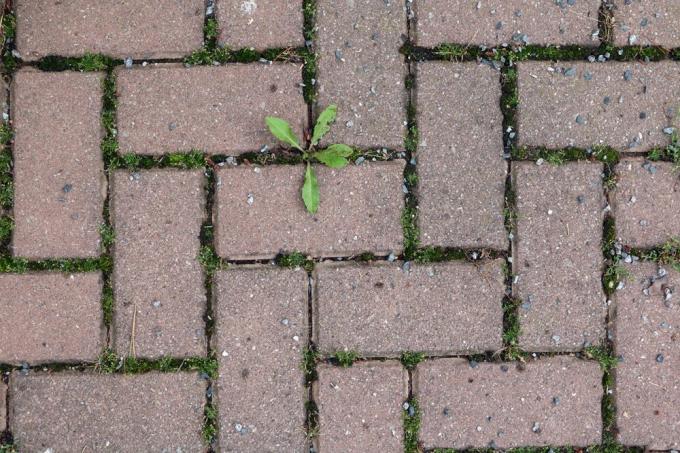
gravel
You can achieve the best precautionary measure if you choose the optimal substrate when planning the paving stones. A deep layer of gravel or crushed stone is common here, which should be at least 25 centimeters before it is "compacted" into a dense, smooth layer. This makes it difficult for many types of grout weeds to establish roots in the soil.
However, there are also some weed species that do not need soil, such as moss. This in turn forms an excellent basis for the growth of other weeds. But as a rule, with a sufficiently thick layer of gravel or crushed stone under the paving stones, you should have peace of mind from weeds in the joints for the first few years.
weed fleece
In addition to the gravel, a special weed fleece promises permanent prevention of weeds in the joints. This is laid on top of the gravel or gravel layer before paving. High-quality fleeces last for decades and are so densely networked that it is almost impossible for roots or other plant parts to get through. But it still allows moisture to seep through.
joint closure
Chippings, earth or sandy mortar are usually used to close the joints in paving stones. However, this is less advisable for weed prevention. There are special pavement joint mortars that seal the joints much more, but still retain water-permeable properties. If you want to be on the safe side, use a joint mortar that is completely waterproof and therefore does not offer any surface for seeds or roots to attack.
However, this has the disadvantage that rainwater can collect on the paving if the paving is not exactly on a level that allows the water to drain off evenly. Incidentally, joint mortar can also be applied later.
vinegar cleaning
Although vinegar is prohibited as a weed killer on paved paths, a Vinegar cleaner or vinegar-water mixture are used in lower concentration and the for weed prevention. If you use vinegar to clean the paving stones regularly, you can remove even the smallest weed growth with the finest structure. It is best if you use a robust scrubbing brush or hard broom when cleaning, so that you can, for example, safely remove stuck seeds from the stones. During the summer months, a vinegar cleaning is recommended approximately every two weeks. But make sure you only use as much vinegar cleaner as you would for normal cleaning.
sealing
During sealing, the paving stones are completely covered with a protective film. However, sealed joints are required for this. The seal not only keeps the paving stones looking like new for a long time, but also serves to prevent green plants from settling on them or in the joints.
Conclusion
Fighting weeds in the joints between paving stones is generally an unpopular activity. There will probably not be general weed protection for eternity, but thanks to effective methods such as those described here, you can at least do it for yourself choose the best option and with some applications also weed-free paving for a whole summer and, depending on prevention, also for many years cause. These tips and tricks will save you time, money and unnecessary effort.
 garden editorial
garden editorial I write about everything that interests me in my garden.
Learn more about weed control

Combat field horsetail - this is how you destroy it permanently
The field horsetail is a dreadful terror for many gardeners because it spreads quickly and can infest large areas. In addition, the weeds can only be controlled with great effort and are relatively difficult to remove permanently.

Fight stinging nettles - this is how you destroy nettles permanently
With their vehement urge to spread and painful stinging hairs, stinging nettles spread fear and terror in the garden. So that the weeds in the bed do not develop from extras to protagonists, they should be fought at an early stage. This guide explains the best strategies to get rid of nettles permanently.
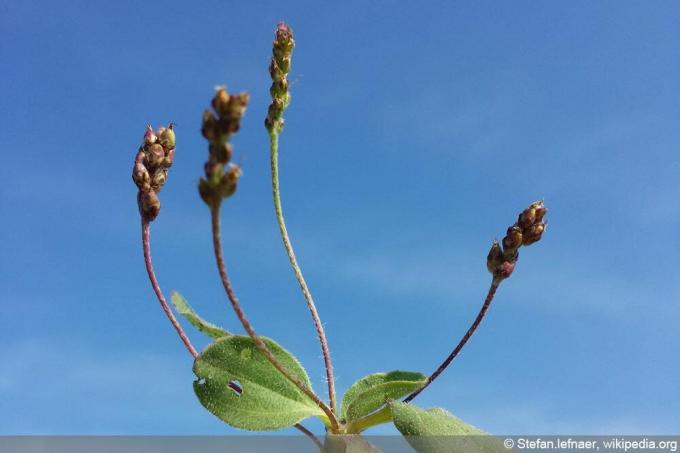
Combat plantain - combat weeds
Although plantain is known as a medicinal plant, it is very unpopular as a weed in well-tended gardens. It spreads rapidly, and there is suppression of shallow-rooted plants and grasses. With the right approach, plantain can be permanently removed in a number of ways. The home garden guide explains how to do this.
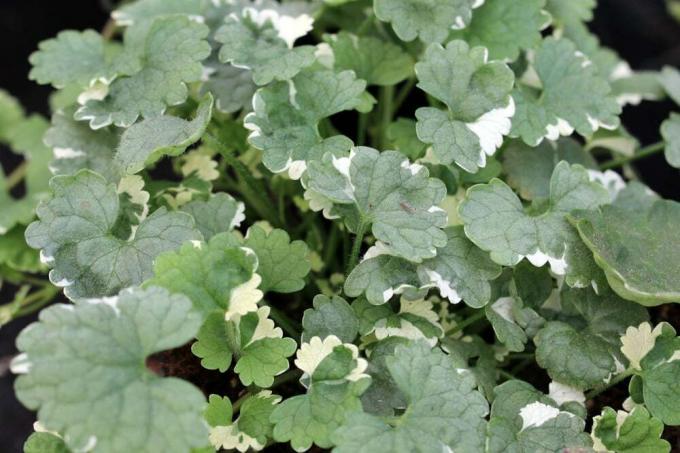
Fight ground ivy in the lawn - this is how you get rid of the weeds
Gundel vine is one of the many weeds that are unpopular among lawn owners. The inconspicuous plant with the pretty purple flowers can quickly become a nuisance if it is allowed to spread unhindered. Fighting them is not that easy. You can find out here how to combat ground ivy in the lawn.
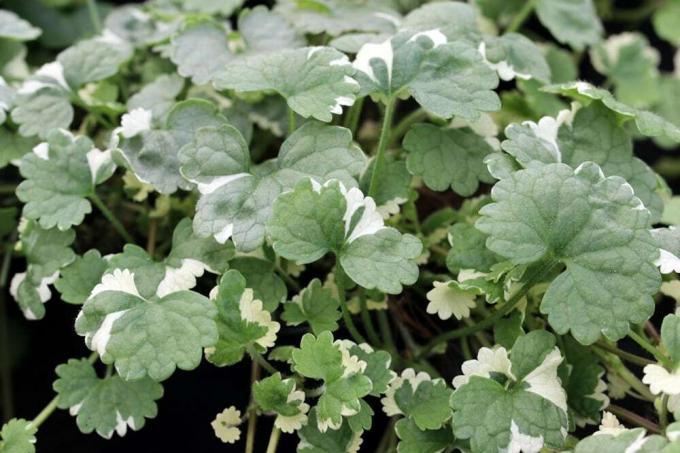
Combat Gundermann in the lawn - can you scarify it?
The ground ivy (Glechoma hederacea) is a wonderfully flowering ground cover, but as a weed it does not stop at well-kept lawns. It proliferates over the lawn at breakneck speed and is not that easy to remove. But with the tips and the professional instructions from the home garden guide, it works reliably.

Burning weeds properly - is burning forbidden?
One of the most environmentally friendly methods of destroying unwanted weeds is scorching. Since the use of chemical weed killers is prohibited on paths and paving stones, flaming is particularly suitable here. You can find out here how you can burn weeds quickly and efficiently in the future.
